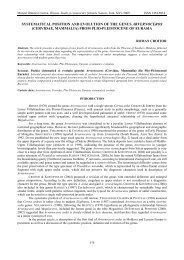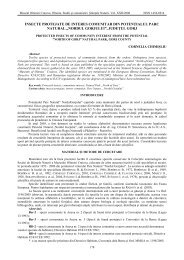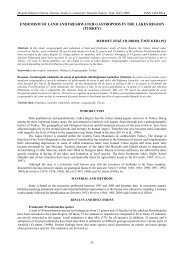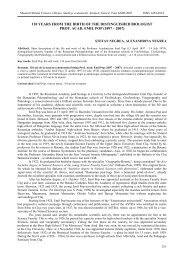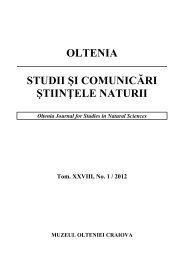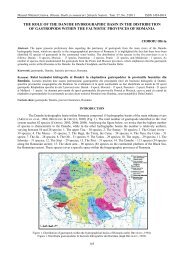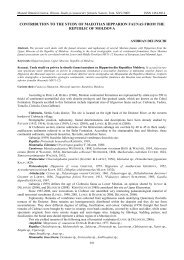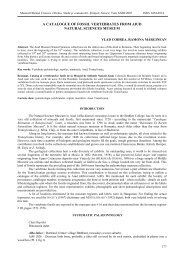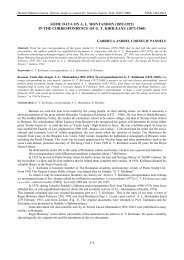helicoid land snails from the province of malatya, turkey and the ...
helicoid land snails from the province of malatya, turkey and the ...
helicoid land snails from the province of malatya, turkey and the ...
You also want an ePaper? Increase the reach of your titles
YUMPU automatically turns print PDFs into web optimized ePapers that Google loves.
Muzeul Olteniei Craiova. Oltenia. Studii i comunicri. tiinele Naturii. Tom. 28, No. 1/2012 ISSN 1454-6914<br />
HELICOID LAND SNAILS FROM THE PROVINCE OF MALATYA, TURKEY<br />
AND THE SURROUNDING AREA<br />
MUSTAFA Öztop, MEHMET ZEK Yıldırım<br />
Abstract. The purpose <strong>of</strong> this study was to identify <strong>and</strong> document species belonging to <strong>the</strong> superfamily Helicoidea (Gastropoda: Pulmonata)<br />
found in <strong>the</strong> <strong>province</strong> Malatya <strong>and</strong> <strong>the</strong> surrounding area. Samples <strong>from</strong> 43 different localities were collected. A total <strong>of</strong> 4 genera <strong>and</strong> 7<br />
species belonging to two families within <strong>the</strong> superfamily Helicoidea were identified. Of <strong>the</strong>se species, Monacha melitenensis, M.<br />
samsunensis, Xeropicta krynickii <strong>and</strong> X. derbentina belong to <strong>the</strong> family Hygromiidae TRYON 1866 <strong>and</strong> Assyriella guttata, Helix pa<strong>the</strong>tica<br />
<strong>and</strong> <strong>the</strong> Turkish snail Helix lucorum to <strong>the</strong> family Helicidae RAFINESQUE 1815. These are <strong>the</strong> first records <strong>of</strong> X. krynickii <strong>and</strong> H. (P.)<br />
pa<strong>the</strong>tica <strong>from</strong> <strong>the</strong> study area; <strong>the</strong> occurrence <strong>of</strong> Helix pa<strong>the</strong>tica MOUSSON 1854 is quite significant as its distribution area in Turkey.<br />
Keywords: Assyriella, Helicoidea, Monacha, Xeropicta, Anatolia, Malatya, Turkey.<br />
Rezumat. Melci helicoizi din provincia Malatya, Turcia i din zona înconjurtoare. Scopul acestui studiu a fost de a<br />
identifica i cunoate speciile care aparin suprafamiliei Helicoidea (Gastropoda: Pulmonata) gsite în provincia Malatya i zona<br />
înconjurtoare. Au fost colectate probe din 43 localiti diferite. Au fost identificate în total 4 genuri i 7 specii aparinând la dou<br />
familii din cadrul suprafamiliei Helicoidea. Dintre aceste specii, Monacha melitenensis, M. samsunensis, Xeropicta krynickii i X.<br />
derbentina aparin familiei Hygromiidae TRYON 1866 i Assyriella guttata, Helix pa<strong>the</strong>tica i H. lucorum familiei Helicidae<br />
RAFINESQUE 1815. În zona studiat sunt primele semnalri ale speciilor X. krynickii i H. (P.) pa<strong>the</strong>tica; prezena lui Helix pa<strong>the</strong>tica<br />
MOUSSON 1854 este destul de semnificativ pentru arealul din Turcia.<br />
Cuvinte cheie: Assyriella, Helicoidea, Monacha, Xeropicta, Anatolia, Malatya, Turcia.<br />
INTRODUCTION<br />
Helicoidea, one <strong>of</strong> <strong>the</strong> most studied stylommatophoran groups (MANGANELLI et al., 2005), is a large<br />
superfamily with over 2500 species worldwide (SCHILEYKO, 1978). Helicoids make up more than a quarter <strong>of</strong> <strong>l<strong>and</strong></strong> snail<br />
species described <strong>from</strong> Turkey so far (SCHÜTT, 2010).<br />
Helicoid species live in a wide range <strong>of</strong> habitats. Although <strong>the</strong> greatest diversity at species level is likely to be seen in<br />
warm temperate habitats, <strong>the</strong>y show distribution <strong>and</strong> speciation in a wide variety <strong>of</strong> o<strong>the</strong>r environments <strong>from</strong> hot <strong>and</strong> dry<br />
deserts to rain forests (PEAKE, 1978), <strong>and</strong> hence constitute a significant part <strong>of</strong> <strong>l<strong>and</strong></strong> snail biodiversity worldwide (STEINKE et<br />
al., 2004). Thus, <strong>helicoid</strong> species exhibit a semi-cosmopolitan distribution, being absent only in <strong>the</strong> south <strong>of</strong> South America,<br />
most <strong>of</strong> Africa (especially <strong>the</strong> south <strong>of</strong> <strong>the</strong> Sahara Desert) <strong>and</strong> some Pacific Is<strong>l<strong>and</strong></strong>s (SCHILEYKO, 1978, 2006a, 2006b; SCOTT,<br />
1997). The shell shape <strong>of</strong> <strong>helicoid</strong> <strong>snails</strong> exhibits considerable variation <strong>from</strong> flat, depressed to high conical, cylindrical. Shell<br />
size is quite variable: shell height may reach 6 cm in species with a globular shape (like <strong>the</strong> genus Helix), or more than 6 cm in<br />
species with a high conical, cylindrical shape (SCHILEYKO, 1978). Systematic <strong>and</strong> taxonomic studies have traditionally<br />
focussed mainly on genital anatomy <strong>and</strong> shell shape. More recently, molecular studies using nuclear ribosomal RNA genes,<br />
mitochondrial DNA <strong>and</strong> nuclear DNA have started to gain an increasing importance (STEINKE et al., 2004; MANGANELLI et<br />
al., 2005). Unfortunately, no molecular studies have been yet undertaken on Turkish <strong>helicoid</strong> <strong>l<strong>and</strong></strong> <strong>snails</strong>.<br />
Most <strong>of</strong> <strong>the</strong> studies contributing to our knowledge <strong>of</strong> <strong>the</strong> general distribution <strong>of</strong> <strong>helicoid</strong> species in Turkey have<br />
been carried out by foreign researchers, starting about 200 years ago. The first Turkish <strong>helicoid</strong> species, Assyriella guttata,<br />
was described <strong>from</strong> Urfa by OLIVIER (1804). The first general review <strong>of</strong> <strong>the</strong> species <strong>of</strong> <strong>the</strong> genus Assyriella was made by<br />
BOURGUIGNAT (1863-1868), who described <strong>the</strong> species Assyriella escheriana <strong>from</strong> Diyarbakır <strong>and</strong> included in this genus<br />
<strong>the</strong> species “djulfensis, michoniana <strong>and</strong> guttata” <strong>from</strong> Eastern <strong>and</strong> Sou<strong>the</strong>astern Anatolia. MARTENS (1874), who carried<br />
out conchological studies in areas including Malatya, Adıyaman, Elazı, Diyarbakır <strong>and</strong> anlıurfa <strong>province</strong>s, collected<br />
samples <strong>of</strong> Assyriella guttata <strong>from</strong> Malatya <strong>and</strong> Diyarbakır <strong>province</strong>s. In his studies <strong>of</strong> <strong>the</strong> species <strong>of</strong> Assyriella,GALLAND<br />
(1885) described new varieties <strong>of</strong> Assyriella guttata <strong>and</strong> A. escheriana <strong>from</strong> Malatya <strong>and</strong> Diyarbakır <strong>province</strong>s. HESSE<br />
(1915) described Monacha melitenensis <strong>from</strong> near <strong>the</strong> Euphrates River, Malatya. WAGNER (1937, 1938) collected samples<br />
<strong>of</strong> Xeropicta derbentina <strong>and</strong> Monacha melitenensis <strong>from</strong> Malatya. From samples <strong>of</strong> Helicidae collected by Dutch students<br />
in biological excursions to Turkey in 1959, HUDEC (1973) described new species <strong>and</strong> subspecies <strong>and</strong> gave systematic,<br />
zoogeographical <strong>and</strong> taxonomic information about <strong>the</strong>m, making a major contribution to our knowledge <strong>of</strong> Monacha<br />
melitenensis, M. samsunensis, Xeropicta derbentina <strong>and</strong> Helix lucorum near <strong>the</strong> study area.<br />
Malatya <strong>and</strong> <strong>the</strong> surrounding area, one <strong>of</strong> poorly-known areas in terms <strong>of</strong> malacological studies, is situated on<br />
<strong>the</strong> Sou<strong>the</strong>astern Taurus – Anatolian Platform in <strong>the</strong> western part <strong>of</strong> <strong>the</strong> Eastern Anatolian Region (37<br />
179<br />
o 56 ' – 39 o 07 ' N,<br />
37 o 16 ' – 38 o 55' E) <strong>and</strong> has characteristics which are transitional between nor<strong>the</strong>rn <strong>and</strong> sou<strong>the</strong>rn Anatolia. Its elevation<br />
ranges <strong>from</strong> about 700 m to over 2500 m, averaging 1350 m. Its predominant climate is continental, with relatively low<br />
rainfall (ATALAY &MORTAN, 2006). The vegetation <strong>of</strong> <strong>the</strong> study area consists predominantly <strong>of</strong> Iran-Turanian<br />
phytogeographical steppe elements, which are very common almost everywhere, such as Bromus, Stipa, Astragalus,<br />
Papaver, Thymus, Euphorbia, <strong>and</strong> Festuca (ATALAY &MORTAN, 2006). As this suggests, <strong>the</strong> <strong>l<strong>and</strong></strong> snail species<br />
recorded so far <strong>from</strong> <strong>the</strong> study area are xerophilic or mesophilic; diversity is relatively low, possibly as a result <strong>of</strong>
MUSTAFA Öztop MEHMET ZEK Yıldırım<br />
widespread volcanic activity, especially <strong>of</strong> <strong>the</strong> late Miocene date (ARGER et al., 2000), <strong>and</strong> a shortage <strong>of</strong> limestone<br />
areas. The aim <strong>of</strong> <strong>the</strong> study presented here is to document species belonging to <strong>the</strong> superfamily Helicoidea (Gastropoda:<br />
Pulmonata) <strong>from</strong> Malatya <strong>province</strong> <strong>and</strong> <strong>the</strong> surrounding area <strong>and</strong> to add to what is already known.<br />
MATERIAL AND METHODS<br />
43 sampling sites were chosen to reflect <strong>the</strong> geographical <strong>and</strong> ecological characteristics <strong>of</strong> <strong>the</strong> study area (Fig.<br />
1, Table 1). Field trips were carried out at 3 different periods between October 2009 <strong>and</strong> September 2010, on dates<br />
chosen to optimise <strong>the</strong> chances <strong>of</strong> finding live adults (WIKTOR, 2000). Empty shells <strong>and</strong> living materials were both<br />
collected. Living specimens were killed in a relaxed state by cleaning <strong>the</strong>m <strong>of</strong> mucus <strong>and</strong> dirt, placing <strong>the</strong>m in a test<br />
tube or a jar so large that <strong>the</strong>y could freely move <strong>and</strong> <strong>the</strong>ir muscles extend, <strong>and</strong> <strong>the</strong>n drowning in water for 12-14 hours.<br />
Once dead, <strong>the</strong>y were rinsed with cold water to remove mucus (WIKTOR, 2000) <strong>and</strong> preserved in 80% ethyl alcohol with<br />
<strong>the</strong> addition <strong>of</strong> 5% glycerine to facilitate later dissection.<br />
Empty shells were examined with a dissection microscope (Olympus SZ61); photographs were taken with an<br />
Infinity Lite Microscope Camera mounted on <strong>the</strong> dissection microscope <strong>and</strong> with digital cameras (Fujifilm FinePix<br />
s8000fd <strong>and</strong> Nikon P90). For <strong>the</strong> identification <strong>of</strong> specimens, structural characteristics, such as shell height <strong>and</strong> shell width<br />
(ÖRSTAN, 2003), aperture height <strong>and</strong> aperture width (FIORENTINO et al., 2008) <strong>and</strong> whorl number (KERNEY et al., 1983)<br />
were examined. The identification <strong>of</strong> species followed SCHÜTT &SUBAI (1996), HAUSDORF (2000) <strong>and</strong> SCHÜTT (2010).<br />
Measurements <strong>of</strong> shell height, shell width, aperture height <strong>and</strong> aperture width were made using a digital<br />
calliper with 0.1 mm accuracy. Measurements <strong>of</strong> <strong>the</strong>se characteristics were carried out with multi-read method. The<br />
following abbreviations have been used in <strong>the</strong> descriptive text <strong>and</strong> tables: D, shell width <strong>and</strong> Dmean, average shell width;<br />
H, shell height <strong>and</strong> Hmean, average shell height; AD, aperture width <strong>and</strong> ADmean, average aperture width; AH, aperture<br />
height <strong>and</strong> AHmean, average aperture height; mm, millimetre; m, meter; N, North; E, east.<br />
RESULTS AND DISCUSSIONS<br />
Genus Monacha FITZINGER 1833<br />
Subgenus Monacha FITZINGER 1833<br />
Monacha (Monacha) melitenensis HESSE 1915<br />
Description (Fig. 2): Shell dextral, depressed <strong>and</strong> conical-globular; with 4 1 /2 - 6 1 /4 convex whorls; teleconch rounded or<br />
slightly angular, with last whorl large <strong>and</strong> more than 2/3 <strong>of</strong> shell height, changing <strong>from</strong> brownish corneous to greywhite<br />
with a lighter peripheral b<strong>and</strong> <strong>and</strong> becoming paler in lower whorls; protoconch usually darker brownish.<br />
Teleconch with more or less strong wrinkled growth-ridges <strong>and</strong> more or less distinct spiral striae; shell surface covered<br />
with hairs 0.5 mm in length, with scattered hair scars on upper whorls in older specimens. Aperture elliptical or almost<br />
circular; upper insertion <strong>of</strong> <strong>the</strong> peristome slightly or distinctly descending; peristome sharp, hardly exp<strong>and</strong>ed, with a strong,<br />
pinkish-white internal lip; umbilicus missing or very narrow <strong>and</strong> largely obscured by <strong>the</strong> reflected columellar edge.<br />
Measurements (n=15): D = 10.53 – 13.09 mm, Dmean = 11.34 mm; H = 7.15 – 9.85 mm, Hmean = 7.95 mm; AD = 4.80 –<br />
5.63 mm, ADmean= 5.18 mm; AH = 5.64 – 6.67 mm, AHmean= 6.05 mm.<br />
Materials examined: From localities 1, 18, 19, 24, 25, 26, 27, <strong>and</strong> 29.<br />
Distribution: So far reported <strong>from</strong> Adana, Malatya, Elazı, Tunceli, Diyarbakır <strong>and</strong> Siirt <strong>province</strong>s in Turkey. Found<br />
under leaf debris <strong>and</strong> on grass, especially in damp areas with poplar trees.<br />
Subgenus Meta<strong>the</strong>ba HESSE 1914<br />
Monacha (Meta<strong>the</strong>ba) samsunensis PFEIFFER 1868<br />
Description (Fig. 3): Shell dextral, depressed, conical-globular; teleconch <strong>and</strong> protoconch with 5-6½ <strong>and</strong> ¾-1¼ convex<br />
whorls, respectively; spire height close to or slightly smaller than <strong>the</strong> aperture height; last whorl larger 3/2 times or<br />
more than penultimate whorl, rounded in adults (but keeled in juveniles); whitish or light corneous with a faintly paler<br />
peripheral b<strong>and</strong>. Teleconch with wrinkled growth-ridges, lower whorls with more or less distinctive incised spiral striae;<br />
sometimes sculpture with fine, radial striae; lower whorls with sparse hairs about 0.5 mm in length or hair scars.<br />
Aperture elliptical or rounded; upper insertion <strong>of</strong> <strong>the</strong> peristome usually distinctly descending; peristome sharp, hardly<br />
exp<strong>and</strong>ed, with a strong whitish internal lip being slightly larger at its edges; umbilicus narrow or very narrow, partly or<br />
nearly completely obscured by <strong>the</strong> reflected columellar edge.<br />
Measurements (n=15): D = 8.28 – 12.63 mm, Dmean = 10.71 mm; H = 5.98 – 9.46 mm, Hmean= 7.77 mm; AD = 3.23 –<br />
6.06 mm, ADmean= 4.74 mm; AH = 4.27 – 7.07 mm, AHmean= 5.71 mm.<br />
Materials examined: From localities 7, 10, 12, 13, 17, 21, 22, 23, 30, 32, 33, 34, 39, 40, 41 <strong>and</strong> 43.<br />
Distribution: So far reported <strong>from</strong> Bilecik, Adapazarı, Bolu, Zonguldak, Karabük, Kastamonu, Sinop, Samsun, Ordu,<br />
Giresun, Trabzon, Rize, Artvin, Çankırı, Çorum, Amasya, Tokat, Ankara, Sivas, Gümühane, Erzurum, Erzincan, Malatya,<br />
Tunceli <strong>and</strong> Van <strong>province</strong>s in Turkey. Found under leaf debris <strong>and</strong> on grass, especially in damp areas with poplar trees.<br />
Genus Xeropicta MONTEROSATO 1892<br />
Xeropicta krynickii KRYNICKI 1833<br />
Description (Fig. 4): Shell dextral, with 5-6 convex whorls; small, dome-shaped or more <strong>of</strong>ten conical; shell height not<br />
more than half <strong>of</strong> <strong>the</strong> height <strong>of</strong> aperture; with 5 to 6 convex whorls; upper whorls slowly increasing <strong>and</strong> slightly convex;<br />
last whorl with pronounced bulge, convex <strong>and</strong> rounded at periphery <strong>and</strong> twice as large as penultimate whorl; with white<br />
180
Muzeul Olteniei Craiova. Oltenia. Studii i comunicri. tiinele Naturii. Tom. 28, No. 1/2012 ISSN 1454-6914<br />
or dark b<strong>and</strong>s <strong>and</strong> spots; <strong>the</strong> number <strong>of</strong> b<strong>and</strong>s <strong>and</strong> <strong>the</strong> degree <strong>of</strong> <strong>the</strong>ir appearance quite variable; in most specimens,<br />
firstly <strong>the</strong> b<strong>and</strong> above <strong>the</strong> suture passing <strong>from</strong> last whorl <strong>and</strong> reaching <strong>the</strong> suture <strong>of</strong> <strong>the</strong> previous <strong>and</strong> embryonic whorls;<br />
secondly only one b<strong>and</strong> shell below. Sculpture with fine <strong>and</strong> irregular radial striae <strong>and</strong> spiral grooves, expressed in<br />
varying degrees. Aperture slightly descending, relatively large, rounded, oblique <strong>and</strong> cut <strong>of</strong>f weakly by penultimate<br />
whorl; <strong>the</strong> insertion points <strong>of</strong> <strong>the</strong> peristome approaching each o<strong>the</strong>r to some extent; peristome fine <strong>and</strong> distinctive, in<br />
some specimens with very fine, distinctive lip; umbilicus characteristic <strong>and</strong> more than half <strong>of</strong> penultimate whorl cannot<br />
be seen <strong>from</strong> <strong>the</strong> umbilicus; umbilical space not large <strong>and</strong> excentric.<br />
Measurements (n=15): D = 11.17 – 14.15 mm, Dmean= 12.61 mm; H = 7.06 – 10.40 mm, Hmean= 9.16 mm; AD = 4.59 –<br />
6.31 mm, ADmean= 5.38 mm; AH = 5.52 – 7.07 mm, AHmean= 6.27 mm.<br />
Materials examined: From localities 10, 30 <strong>and</strong> 40.<br />
Distribution: Reported mainly <strong>from</strong> <strong>the</strong> Black Sea Region in Turkey. Recently reported <strong>from</strong> o<strong>the</strong>r parts <strong>of</strong> Turkey,<br />
presumably introduced in imported soil, natural fertilizers <strong>and</strong> with <strong>l<strong>and</strong></strong>scape plants. Most commonly found in open<br />
habitats, arable fields, <strong>and</strong> sometimes forests <strong>and</strong> s<strong>and</strong>y areas.<br />
Xeropicta derbentina KRYNICKI 1836<br />
Description (Fig. 5): Shell dextral, distinctively depressed to flat; spire height <strong>of</strong>ten not more than half <strong>of</strong> <strong>the</strong> height <strong>of</strong><br />
aperture; with 5-5½ convex whorls; whorls rapidly <strong>and</strong> regularly increasing in size; last whorl rounded <strong>and</strong> about three<br />
times as large as penultimate whorl; chalky-white or with light b<strong>and</strong>s or b<strong>and</strong>s consisting <strong>of</strong> many spots especially<br />
subsuturally. Sculpture with fine, radial striae; spiral grooves indefinite. Aperture slightly descending; very <strong>of</strong>ten almost<br />
rounded, with a whitish or lighter pinkish-white internal lip <strong>and</strong> slightly oblique; <strong>the</strong> insertion points close to each o<strong>the</strong>r;<br />
peristome edges fine, distinctive <strong>and</strong> complete, but quite fragile; umbilicus concentric <strong>and</strong> a whole whorl or 3/2 whorl,<br />
albeit rarely, can be seen <strong>from</strong> <strong>the</strong> umbilicus.<br />
Measurements (n=15): D = 11.78 – 14.51 mm, Dmean= 13.19 mm; H = 7.44 – 10.07 mm, Hmean= 8.42 mm; AD = 4.63 –<br />
6.48 mm, ADmean= 5.63 mm; AH = 5.05 – 6.92 mm, AHmean= 6.23 mm.<br />
Materials examined: From localities 1, 2, 4, 6, 7, 9, 19, 20, 21, 27, 28, 31, 33, 34, 35, 36, 37, 38, 39, 41, <strong>and</strong> 42.<br />
Distribution: A successful invasive species known <strong>from</strong> many steppic <strong>and</strong> xero<strong>the</strong>rmophilic areas in Turkey because <strong>of</strong><br />
its introduction in imported soil, natural fertilizers, with <strong>l<strong>and</strong></strong>scape plants, etc. Prefers all kinds <strong>of</strong> dry grassy places <strong>and</strong><br />
forms heaps on walls <strong>and</strong> trees.<br />
Genus Assyriella HESSE 1908<br />
Assyriella guttata OLIVIER 1804<br />
Description (Fig. 6): Shell dextral, small to medium - sized <strong>and</strong> depressed globular with broad conical spire; teleconch<br />
<strong>and</strong> protoconch with 4 - 4¾ <strong>and</strong> 1¾ whorls, respectively; embryonic whorls not shouldered but very vaulted; teleconch<br />
with regularly increasing whorls, last whorl two times or so larger than penultimate whorl <strong>and</strong> descending abruptly<br />
towards aperture; protoconch slightly vaulted, strong shouldered <strong>and</strong> with coarse granulation (0.05-0.20 mm) or<br />
sculpture with long line existing radial striped; teleconch smooth or with very fine granulation on upper whorls, with<br />
very irregular, strong radial striped sculpture; in some specimens, a few spiral grooves visible subsuturally; teleconch<br />
dirty white with five brown b<strong>and</strong>s; upper b<strong>and</strong> very narrow <strong>and</strong> pale, hardly visible; second <strong>and</strong> third b<strong>and</strong>s <strong>of</strong>ten<br />
merged, but fourth <strong>and</strong> fifth b<strong>and</strong>s widely spaced; fourth b<strong>and</strong> wide <strong>and</strong> quite pronounced; fifth b<strong>and</strong> narrower <strong>and</strong><br />
hardly visible or missing; b<strong>and</strong>s <strong>of</strong>ten interrupted by white, radial zigzag-lines.; Aperture obliquely oval or very<br />
rounded, in some specimens dental lamina raised slightly in <strong>the</strong> centre <strong>of</strong> <strong>the</strong> lower aperture; <strong>the</strong> insertion points <strong>of</strong> <strong>the</strong><br />
peristome 8-10,5 mm apart, connected by a thin, distinct callus; aperture edges white, sharp, reflected nearly uniformly<br />
but thickened towards <strong>the</strong> columellar edge; umbilicus completely closed or with a very narrow gap.<br />
Measurements (n=15): D = 26.44 – 37.04 mm, Dmean= 32.76 mm; H = 15.29 – 23.21 mm, Hmean= 19.85 mm; AD =<br />
14.00 – 23.37 mm, ADmean= 19.19 mm; AH = 13.13 – 19.96 mm, AHmean= 17.31 mm.<br />
Materials examined: From localities 3, 5, 14, 15, <strong>and</strong> 16.<br />
Distribution: So far reported <strong>from</strong> Adana, Adıyaman, Diyarbakır, Elazı, Erzincan (in this study), Malatya <strong>and</strong><br />
anlıurfa <strong>province</strong>s in Turkey. Found in rocky habitats in crevices, cracks, <strong>and</strong> rarely in basalt areas.<br />
Genus Helix LINNAEUS 1758<br />
Subgenus Pelasga HESSE 1908<br />
Helix (Pelasga) pa<strong>the</strong>tica MOUSSON 1854<br />
Description (Fig. 7): Shell dextral, small when compared with o<strong>the</strong>r Helix species; teleconch <strong>and</strong> protoconch with 4-5<br />
<strong>and</strong> 1-1¾ whorls, respectively; globular with broad conical spire <strong>and</strong> pointed apex; thin-walled <strong>and</strong> translucent, last<br />
whorl broader <strong>and</strong> descending slightly towards <strong>the</strong> aperture; 4-5 reddish light brown b<strong>and</strong>s. Very fine growth-ridges.<br />
Aperture oblique or rounded; inside white, with b<strong>and</strong>s shining through <strong>and</strong> thin glossy lip; peristome sharp, only below<br />
broadened <strong>and</strong> reflected towards umbilicus; umbilicus almost completely obscured by <strong>the</strong> reflected columellar edge; <strong>the</strong><br />
insertion points <strong>of</strong> peristome distant <strong>and</strong> connected by a thinner callus.<br />
Measurements (n=6): D = 22.15 – 27.85 mm, Dmean= 25.25 mm; H = 24.48 – 29.35 mm, Hmean= 26.87 mm; AD = 14.38 –<br />
18.17 mm, ADmean= 16.81 mm; AH = 15.20 – 19.30 mm, AHmean= 17.65 mm.<br />
Materials examined: From locality 8<br />
Distribution: So far reported <strong>from</strong> Samsun, Amasya, Tokat, Kahramanmara (in this study) <strong>and</strong> Çorum <strong>province</strong>s in<br />
Turkey. Prefers gently sloping limestone cliffs <strong>and</strong> open habitats.<br />
181
MUSTAFA Öztop MEHMET ZEK Yıldırım<br />
Subgenus Helix LINNAEUS 1758<br />
Helix (Helix) lucorum LINNAEUS 1758<br />
Description (Fig. 8): Shell dextral medium to large sized with 4 - 4½ slightly convex whorls; slightly blunt-conical,<br />
depressed globose with more or less broad conically elevated spire, nearly as high as it is wide; protoconch smooth <strong>and</strong><br />
convex; last whorl inflated distinctly, especially in width; usually pale brown, variably striped radially; dark stripes on <strong>the</strong><br />
upper whorls. Sculpture with prominent radial folds, strong at <strong>the</strong> sutures; may show some spiral grooving. Aperture oval,<br />
rounded or oblique; lip whitish <strong>and</strong> shiny inside; <strong>the</strong> edge <strong>of</strong> <strong>the</strong> aperture blunt <strong>and</strong> slightly thickened, white or pale brown,<br />
not reflected or only reflected on <strong>the</strong> columellar edge; umbilicus partly or completely sealed by <strong>the</strong> columellar edge.<br />
Measurements (n=15): D = 35.36 – 47.91 mm, Dmean= 41.49 mm; H = 35.79 – 47.23 mm, Hmean= 42.13 mm; AD =<br />
20.01 – 29.07 mm, ADmean= 24.52 mm; AH = 21.01 – 27.89 mm, AHmean= 25.11 mm.<br />
Materials examined: From localities 5, 22, 33, 34, <strong>and</strong> 41.<br />
Distribution: Known <strong>from</strong> many areas <strong>of</strong> Turkey because <strong>of</strong> its introduction into many places by various ways, such as<br />
in imported soil, natural fertilizers, with <strong>l<strong>and</strong></strong>scape plants, through <strong>the</strong> consumption <strong>of</strong> human food, etc. Prefers bushy,<br />
forested <strong>and</strong> grassy areas, as well as gardens.<br />
We found 7 species belonging to Helicoidea. Of <strong>the</strong>se species, 4 are classified in <strong>the</strong> family Hygromiidae,<br />
including <strong>the</strong> genera Monacha <strong>and</strong> Xeropicta, <strong>and</strong> 3 in <strong>the</strong> family Helicidae, including <strong>the</strong> genera Assyriella <strong>and</strong> Helix.<br />
The species <strong>of</strong> Xeropicta krynickii <strong>and</strong> Helix (Pelasga) pa<strong>the</strong>tica are reported for <strong>the</strong> first time <strong>from</strong> <strong>the</strong> study area.<br />
Monacha is a widely-distributed hygromid genus with many species. The Anatolian Monacha species are<br />
conchologically very similar, but ecologically ra<strong>the</strong>r diverse, being found in a wide range <strong>of</strong> habitats such as arid<br />
habitats, marshy meadows, woods, etc. <strong>from</strong> coastal areas to alpine altitudes (HAUSDORF, 2000). Their habitats are so<br />
diverse that <strong>the</strong>y can be considered as one <strong>of</strong> <strong>the</strong> most successful groups <strong>of</strong> <strong>l<strong>and</strong></strong> <strong>snails</strong>. In <strong>the</strong> present study, Monacha<br />
melitenensis <strong>and</strong> Monacha samsunensis were found in semi-arid <strong>and</strong> in humid habitats. But at none <strong>of</strong> <strong>the</strong> sample sites<br />
were both species present; as in Albinaria (GITTENBERGER, 1991), two Monacha species rarely occur in <strong>the</strong> same place<br />
(HAUSDORF, 2000). Monacha (Meta<strong>the</strong>ba) samsunensis has one <strong>of</strong> <strong>the</strong> largest distributions <strong>of</strong> <strong>the</strong> genus Monacha,<br />
occurring over a large area <strong>of</strong> <strong>the</strong> Anatolian Plateau <strong>from</strong> Bilecik in <strong>the</strong> west to Van in <strong>the</strong> east, <strong>and</strong> <strong>from</strong> Samsun in <strong>the</strong><br />
north to Malatya in <strong>the</strong> south (HAUSDORF, 2000). In this study, M. (M.) samsunensis is reported for <strong>the</strong> first time <strong>from</strong><br />
Elbistan, but this has not been confirmed anatomically. The o<strong>the</strong>r Monacha species <strong>from</strong> <strong>the</strong> present study area,<br />
Monacha melitenensis, is endemic to Anatolia <strong>and</strong> has a narrower distribution area <strong>from</strong> Adana to Siirt.<br />
Of <strong>the</strong> two species <strong>of</strong> Xeropicta in <strong>the</strong> study area, X. derbentina is more commonly found in Turkey than X.<br />
krynickii. These two species are <strong>of</strong>ten confused; <strong>the</strong>y can best be distinguished by <strong>the</strong> ratio between <strong>of</strong> <strong>the</strong>ir epiphallus <strong>and</strong><br />
flagellum, which is less than or almost equivalent to one fourth in X. derbentina (SCHILEYKO, 1978). In this study, X.<br />
derbentina was found in arid habitats while X. krynickii was found in humid habitats, indicating that <strong>the</strong> heat tolerance <strong>of</strong><br />
X. derbentina is probably higher than X. krynickii. Because, some invasive species, such as Xeropicta derbentina <strong>and</strong><br />
Theba pisana, have high phenotypic plasticity <strong>and</strong> <strong>the</strong>ir juveniles can have interrupted <strong>the</strong>ir growth when climatic<br />
conditions, such as humidity <strong>and</strong> temperature, become unfavourable (COWIE, 1984; BAKER &VOGELZANG, 1988).<br />
Assyriella guttata belongs to a genus which had originated <strong>from</strong> an ancestral stock in <strong>the</strong> Syrian or South<br />
Anatolian area toge<strong>the</strong>r with such genera as Levantina <strong>and</strong> Isaurica, <strong>and</strong> spread northwards <strong>and</strong> eastwards <strong>from</strong> that<br />
area (NEUBERT, 1998). In <strong>the</strong> present study, it was found in rocky habitats <strong>from</strong> Arapgir <strong>and</strong> Aın towards Kemaliye<br />
(Erzincan), an area without many o<strong>the</strong>r <strong>helicoid</strong> species; this is <strong>the</strong> nor<strong>the</strong>rnmost report <strong>of</strong> this species. It is <strong>the</strong><br />
Assyriella species with <strong>the</strong> largest distribution; this is <strong>the</strong> first report <strong>of</strong> its occurrence in Kemaliye. It, however, is likely<br />
it could be found near Kahramanmara <strong>and</strong> Kayseri in <strong>the</strong> northwest <strong>of</strong> Sou<strong>the</strong>ast Taurus (BAYNDIR, 2006).<br />
Helix is <strong>the</strong> largest-sized <strong>l<strong>and</strong></strong> snail genus in <strong>the</strong> western Palaearctic region, as well as in <strong>the</strong> Anatolia. Helix<br />
(Pelasga) pa<strong>the</strong>tica, reported for <strong>the</strong> first time <strong>from</strong> <strong>the</strong> present study area, is endemic to Anatolia. It shows a sparse<br />
distribution on <strong>the</strong> Anatolian plateau <strong>and</strong> occurs in <strong>the</strong> nor<strong>the</strong>rn parts <strong>of</strong> Inner Anatolian Region (SCHÜTT, 2010); this is<br />
its sou<strong>the</strong>rnmost known occurrence. Unlike H. (P.) pa<strong>the</strong>tica, Helix lucorum is a widespread adventive <strong>the</strong>re is plenty <strong>of</strong><br />
evidence indicating that some species <strong>of</strong> Helix, as well as o<strong>the</strong>r edible <strong>snails</strong>, had been consumed as human food<br />
throughout circum-Mediterranean countries in prehistoric times (LUBELL, 2004).<br />
CONCLUSIONS<br />
Of <strong>the</strong> species found in <strong>the</strong> present study, Monacha samsunensis, M. melitenensis, Assyriella guttata <strong>and</strong> Helix<br />
(Pelasga) pa<strong>the</strong>tica can be stated to be native to <strong>the</strong> study area. But, <strong>the</strong> remaining species, Xeropicta derbentina, X.<br />
krynickii <strong>and</strong> Helix (H.) lucorum, may have been transported into <strong>the</strong> study area in various ways, because, <strong>the</strong>se species are<br />
<strong>of</strong>ten found in areas with intensive human activity. Snail eggs or juveniles can hardly ever or rarely be seen without special<br />
equipment, so <strong>the</strong>y are easily introduced in imported soil, natural fertilizers, with <strong>l<strong>and</strong></strong>scape plants, <strong>and</strong> in o<strong>the</strong>r ways.<br />
ACKNOWLEDGEMENTS<br />
This research was supported by BAP (Project No. 0081-YL-09) <strong>of</strong> Mehmet Akif Ersoy University. We would<br />
like to thank BAP for financial support <strong>and</strong> Dr. Sebastian Payne for revising <strong>the</strong> text.<br />
182
Muzeul Olteniei Craiova. Oltenia. Studii i comunicri. tiinele Naturii. Tom. 28, No. 1/2012 ISSN 1454-6914<br />
REFERENCES<br />
ARGER J., MITCHELL J., WESTAWAY R. W. C. 2000. Neogene <strong>and</strong> Quaternary Volcanism <strong>of</strong> Sou<strong>the</strong>astern Turkey. In:<br />
Tectonics <strong>and</strong> Magmatism in Turkey <strong>and</strong> <strong>the</strong> Surrounding Area (BOZKURT E. WINCHESTER J. A. J. D. A. PIPER,<br />
Ed.). Geological Society Special Publications. The Geological Society. London. 173: 459-487.<br />
ATALAY .&MORTAN K. 2006. Türkiye Bölgesel Corafyası, Resimli ve Haritalı. [Regional Geography <strong>of</strong> Turkey, with<br />
illustrated <strong>and</strong> mapped]. nkilap Kitabevi. stanbul: 447-530.<br />
BAKER G. H. & VOGELZANG B. K. 1988. Life history, population dynamics <strong>and</strong> polymorphism <strong>of</strong> Theba pisana<br />
(Mollusca: Helicidae). Journal <strong>of</strong> Applied Ecology. The British Ecology Society. London. 25: 867-887.<br />
BAYINDIR F. 2006. Malatya lindeki Genel Arazi Kullanımının Yükselti Kuaklarına Göre Deiimi [The L<strong>and</strong> Use <strong>of</strong><br />
Malatya Province Changing According To The Hig<strong>l<strong>and</strong></strong>s]. Master Thesis, Supervisor: Pr<strong>of</strong>. dr. Saadettin<br />
Tonbul. The Instituation <strong>of</strong> Social Sciences. Fırat University. Elazı. Turkey: 122 pp.<br />
BOURGUIGNAT J. R. 1863-1868. Mollusques nouveaux, litigieux ou peu connus. Première centurie. Chez Formes Savy.<br />
Paris. 1(40): 1-324.<br />
COWIE R. H. 1984. The life-history <strong>and</strong> productivity <strong>of</strong> <strong>the</strong> <strong>l<strong>and</strong></strong> snail Theba pisana (Mollusca: Helicidae). Journal <strong>of</strong><br />
Animal Ecology. The British Ecology Society. London. 53: 311-325.<br />
FIORENTINO V., SALOMONE N., MANGANELLI G., GIUSTI F. 2008. Phylogeography <strong>and</strong> morphological variability in<br />
<strong>l<strong>and</strong></strong> <strong>snails</strong>: <strong>the</strong> Sicilian Marmorana (Pulmonata, Helicidae). Biological Journal <strong>of</strong> <strong>the</strong> Linnean Society. The<br />
Linnean Society. London. 94: 809-823.<br />
GALLAND J. 1885. Description de quelques formes nouvelles du groupe de l'Helix guttata. Bulletins de la Société<br />
malacologique de France. Tremblay. Paris. 2(7): 231-236.<br />
GITTENBERGER E. 1991. What about non-adaptive radiation? Biological Journal <strong>of</strong> <strong>the</strong> Linnean Society. The Linnean<br />
Society. London. 43: 263-272.<br />
HAUSDORF B. 2000. The genus Monacha in Turkey (Gastropoda: Pulmonata: Hygromiidae). Archiv für Molluskenkunde,<br />
E. Schweizerbartsche Verlagsbuchh<strong>and</strong>lung. Stuttgart. 128: 61-151.<br />
HESSE P. 1915. Beschreibungen neuer Arten. Nachrichtsblatt der Deutschen Malakozoologischen Gesellschaft, Verlag<br />
W. Küchler. Frankfurt. 47: 58-63.<br />
HUDEC V. 1973. Helicidae (Gastropoda, Pulmonata) gesammelt von der niederländischen biologischen Expedition in<br />
die Türkei in 1959. II. Zoologische Mededelingen. University <strong>of</strong> Amsterdam. 46(1): 231-259.<br />
KERNEY M. P., CAMERON R. A., JUNGBLUTH J. H. 1983. Die L<strong>and</strong>schnecken Nordeuropas und Mitteleuropas. Ein<br />
Bestimmungsbuch für Biologen und Naturfreunde (Gebundene Ausgabe). Blackwell Wissenschafts-Verlag,<br />
Hamburg: 21-22.<br />
LUBELL D. 2004. Prehistoric edible <strong>l<strong>and</strong></strong> <strong>snails</strong> in <strong>the</strong> circum-Mediterranean: <strong>the</strong> archaeological evidence. In: Petits<br />
Animaux et Sociétés Humaines. Du Complément Alimentaire Aux Ressources Utilitaires. XXIV e rencontres<br />
internationales d'archéologie et d'histoire d'Antibes (BRUGAL J. J., DESSE J., Ed.). Antibes: Éditions APDCA,<br />
Association pour la Promotion et la Diffusion des Connaissances Archéologiques. Paris: 77-98.<br />
MANGANELLI G., SALOMONE N., GIUSTI F. 2005. A molecular approach to <strong>the</strong> phylogenetic relationships <strong>of</strong> <strong>the</strong> western<br />
Palaearctic Helicoidea (Gastropoda: Stylommatophora). Biological Journal <strong>of</strong> <strong>the</strong> Linnean Society. The<br />
Linnean Society. London. 85: 501-512.<br />
MARTENS E. C. 1874. Ueber vorderasiatische Conchylien, nach den Sammlungen des Pr<strong>of</strong>. Hausknecht mit 9 Taf.<br />
Abbildungen. Cassel. Theodor Fischer. Germany. 9. 127 pp.<br />
NEUBERT E. 1998. Annotated checklist <strong>of</strong> <strong>the</strong> terrestrial <strong>and</strong> freshwater molluscs <strong>of</strong> <strong>the</strong> Arabian Peninsula with<br />
descriptions <strong>of</strong> new species. Fauna <strong>of</strong> Arabia, Senckenberg Reserach Institute <strong>and</strong> Natural History Museum,<br />
Frankfurt. 17: 333-461.<br />
OLIVIER G. A. 1804. Voyage dans l'Empire Othoman, l'Égypte et la Perse, fait par ordre du gouvernement, pendant les<br />
six premières années de la République. H. Agasse. Taf. 18-33. Paris. 2. 466 pp.<br />
ÖRSTAN A. 2003. Calculation <strong>of</strong> <strong>the</strong> coefficient <strong>of</strong> variation <strong>from</strong> <strong>the</strong> diameter measurements <strong>of</strong> snail shells. Triton. The<br />
Israel Malacological Society. Israel. 8: 31-32.<br />
PEAKE J. 1978. Distribution <strong>and</strong> ecology <strong>of</strong> Stylommatophora. In: Pulmonates. Systematics <strong>and</strong> Ecology (FRETTER V.,<br />
PEAKE J. ed.). Academic Press Inc. London. 2A: 429-526.<br />
SCHILEYKO A. A. 1978. Terrestrial mollusks <strong>of</strong> <strong>the</strong> superfamily Helicoidea. (Nauka). Leningrad. Moscow :1-384 [In<br />
Russian].<br />
SCHILEYKO A. A. 2006a. A Treatise on Recent Terrestrial Pulmonate Molluscs. Helicidae. Figs. 2260-2330. Ru<strong>the</strong>nica.<br />
Moscow. 13(2): 1765-1818.<br />
SCHILEYKO A. A. 2006b. A Treatise on Recent Terrestrial Pulmonate Molluscs. Hygromiidae. Figs. 2451-2576.<br />
Ru<strong>the</strong>nica. Moscow. 14(2): 1931-2040.<br />
SCHÜTT H. 2010. Turkish L<strong>and</strong> Snails (5th, revised <strong>and</strong> enlarged edition). Verlag Natur <strong>and</strong> Wissenschaft. Solingen.<br />
560 pp.<br />
SCHÜTT H. & SUBAI P. 1996. Revision der Gattung Assyriella P. Hesse 1908 (Gastropoda: Pulmonata: Helicidae:<br />
Helicinae). Archiv für Molluskenkunde, E. Schweizerbart'sche Verlagsbuchh<strong>and</strong>lung. Stuttgart. 125: 117-161.<br />
183
MUSTAFA Öztop MEHMET ZEK Yıldırım<br />
SCOTT B. 1997. Biogeography <strong>of</strong> <strong>the</strong> Helicoidea (Mollusca: Gastropoda: Pulmonata): <strong>l<strong>and</strong></strong> <strong>snails</strong> with a Pangean<br />
distribution. Journal <strong>of</strong> Biogeography. Blackwell Publishing Ltd. Oxford. 24: 399-407.<br />
STEINKE D., ALBRECHT C., PFENNINGER M. 2004. Molecular phylogeny <strong>and</strong> character evolution in <strong>the</strong> western<br />
Palaearctic Helicidae s.l. (Gastropoda: Stylommatophora). Molecular Phylogenetics <strong>and</strong> Evolution. Elsevier<br />
Inc. Stuttgart. 32: 724-734.<br />
WAGNER J. 1937. Vasvári Miklós 1936. Évi kisázsiai kutatóútjának állattani eredményei. I. Puhatest állatok<br />
(Mollusca). Ma<strong>the</strong>matikai és Természettudományi Értesít. Magyar Tudományos Akadémia. Budapest. 56:<br />
1042-1060. [In Hungarian].<br />
WAGNER J. 1938. Vasvári Miklós második kisázsiai kutatóútjának állattani eredményei. I. Puhatest állatok (Mollusca).<br />
Ma<strong>the</strong>matikai és Természettudományi Értesít. Magyar Tudományos Akadémia. Budapest. 57: 769-777. [In<br />
Hungarian].<br />
WIKTOR A. 2000. Agriolimacidae (Gastropoda: Pulmonata): a systematic monograph. Annales Zoologici. Museum<br />
<strong>and</strong> Institute <strong>of</strong> Zoology. Polish Academy <strong>of</strong> Sciences. Warszawa. 49: 347-590.<br />
184<br />
Table 1. List <strong>of</strong> <strong>the</strong> sampling sites <strong>of</strong> <strong>the</strong> present study.<br />
Tabel 1. Lista siturilor de prelevare a probelor studiate.<br />
No Locality Coordinate Altitude (m)<br />
1 ahaplı Köyü – Baskil / Elazı 38° 32' N; 38° 47' E 1042<br />
2 Kapınar - Aın / Elazı 38° 55' N; 38° 40' E 866<br />
3 Yediba – Aın / Elazı 38° 53' N; 38° 37' E 957<br />
4 Kömürhan / Elazı 38° 26' N; 38° 50' E 700<br />
5 Dutluca / Kemaliye – Erzincan 39° 06' N; 38° 33' E 1115<br />
6 Özbek – Elbistan / Kahramanmara 38° 13' N; 37° 23' E 1302<br />
7 Büyük Yapalak-Elbistan-Darende Yolu 25. km / Elbistan 38° 23' N; 37° 17' E 1345<br />
8 Yeilkent – Kullar Beldesi / Kahramanmara 37° 57' N; 37° 30' E 1298<br />
9 Ören – Dedeyazı Arası / Akçada 38° 14' N; 37° 53' E 1215<br />
10 Sultansuyu / Akçada 38° 25' N; 38° 08' E 747<br />
11 Yukarı Kozluca / Akçada 38° 23' N; 37° 42' E 1446<br />
12 Kozluk – Darıca / Akçada 38° 20' N; 37° 40' E 1545<br />
13 Mollauaı – Tohma Çayı / Akçada 38° 30' N; 37° 49' E 918<br />
14 Arapgir Yolu 67. km / Arapgir 38° 45' N; 38° 27' E 740<br />
15 Karayolları 85. ube eflii Örtülü Bakım Evi Karısı / Arapgir 38° 55' N; 38° 31' E 1377<br />
16 Arapgir Yolu 110. km / Arapgir 38° 58' N; 38° 30' E 1390<br />
17 Kemaliye Yolu /Arapgir 39° 04' N; 38° 30' E 934<br />
18 Asmaca / Arguvan 38° 46' N; 38° 12' E 1014<br />
19 Mollaibrahim – Arguvan Çayı / Arguvan 38° 44' N; 38° 05' E 960<br />
20 Battalgazi / Malatya 38° 25' N; 38° 23' E 801<br />
21 Tohma Çayı – Çatakkaya / Darende 38° 28' N; 37° 41' E 950<br />
22 Aaıulupınar / Darende 38° 26' N; 37° 34' E 1175<br />
23 Günpınar / Darende 38° 33' N; 37° 25' E 1263<br />
24 Sürgü Yol Ayrımı / Doanehir 38° 03' N; 37° 54' E 1319<br />
25 Kasımlar Köyü / Malatya – Adıyaman l Sınırı 37° 59' N; 38° 10' E 1328<br />
26 Elmalı Köyü Çıkıı / Doanehir 38° 03' N; 37° 44' E 1379<br />
27 Çılık / Doanehir 38° 07' N; 37° 55' E 1213<br />
28 Suçatı Köyü – Demiryolu stasyonu / Doanehir 38° 11' N; 37° 58' E 1014<br />
29 Fındık Köyü / Doanehir 38° 07' N; 37° 48' E 1348<br />
30 Hekimhan Çıkıı / Hekimhan 38° 50' N; 37° 54' E 1098<br />
31 Erenli Köyü / Kale 38° 20' N; 38° 40' E 1149<br />
32 Malatya Köy Hizmetleri Bahçesi 38° 20' N; 38° 15' E 936<br />
33 Beyler Deresi / Malatya 38° 19' N; 38° 12' E 919<br />
34 Dilek / Malatya 38° 22' N; 38° 17' E 893<br />
35 Pınarbaı / Malatya 38° 20' N; 38° 22' E 1023<br />
36 Pütürge Çıkıı / Pütürge 38° 11' N; 38° 52' E 1187<br />
37 Yazıhan Karayolu 15. km / Yazıhan 38° 29' N; 38° 13' E 740<br />
38 Hekimhan Karayolu, Demiryolu Tüneli Kuzeyi / Yazıhan 38° 39' N; 38° 09' E 793<br />
39 Gözene Köyü / Yeilyurt 38° 10' N; 38° 02' E 1291<br />
40 Sultansuyu Çayı Dousu / Yeilyurt 38° 12' N; 37° 59' E 970<br />
41 Gündüzbey’in 2 km Güneyi / Yeilyurt 38° 15' N; 38° 16' E 1190<br />
42 Görgü Köyü / Yeilyurt 38° 16' N; 38° 07' E 1168<br />
43 Gürün / Sivas 38° 43' N; 37° 17' E 1378
Muzeul Olteniei Craiova. Oltenia. Studii i comunicri. tiinele Naturii. Tom. 28, No. 1/2012 ISSN 1454-6914<br />
Figure 1. Map <strong>of</strong> <strong>the</strong> study area (after BAYINDIR, 2006). / Figura 1. Harta zonei studiate (dup BAYINDIR, 2006).<br />
Figure 2. The view <strong>of</strong> Monacha (M.) melitenensis <strong>from</strong> three directions (Scale 10 mm).<br />
Figura 2. Vedere Monacha (M.) melitenensis din trei direcii (Scala 10 mm) (original).<br />
Figure 3. The view <strong>of</strong> Monacha (Meta<strong>the</strong>ba) samsunensis <strong>from</strong> three directions (Scale 10 mm).<br />
Figura 3. Vedere Monacha (Meta<strong>the</strong>ba) samsunensis din trei direcii (Scala 10 mm) (original).<br />
Figure 4. The view <strong>of</strong> Xeropicta krynickii <strong>from</strong> three directions (Scale 10 mm).<br />
Figura 4. Vedere Xeropicta krynickii din trei direcii (Scala 10 mm) (original).<br />
185
MUSTAFA Öztop MEHMET ZEK Yıldırım<br />
Figure 5. The view <strong>of</strong> Xeropicta derbentina <strong>from</strong> two directions (Scale 10 mm).<br />
Figura 5. Vedere Xeropicta derbentina din dou direcii (Scala 10 mm) (original).<br />
Figure 6. The view <strong>of</strong> Assyriella guttata <strong>from</strong> three directions (Scale 10 mm).<br />
Figura 6. Vedere Assyriella guttata din trei direcii (Scala 10 mm) (original).<br />
Figure 7. The view <strong>of</strong> Helix (Pelasga) pa<strong>the</strong>tica <strong>from</strong> three directions (Scale 10 mm).<br />
Figura 7. Vedere Helix (Pelasga) pa<strong>the</strong>tica din trei direcii (Scala 10 mm) (original).<br />
Figure 8. The view <strong>of</strong> Helix (H.) lucorum <strong>from</strong> three directions (Scale 10 mm).<br />
Figura 8. Vedere Helix (H.) lucorum din trei direcii (Scala 10 mm) (original).<br />
Mustafa Öztop<br />
M. Akif Ersoy University,<br />
stiklal Campus, 15030, Burdur – Turkey,<br />
E-mail: mustafa_904409@yahoo.com<br />
186<br />
Mehmet Zeki Yıldırım<br />
M. Akif Ersoy University,<br />
Bahçelievler Mah., 15100, Burdur – Turkey,<br />
E-mail: mzekiyildirim@gmail.com<br />
Received: February 23, 2012<br />
Accepted: June 23, 2012



